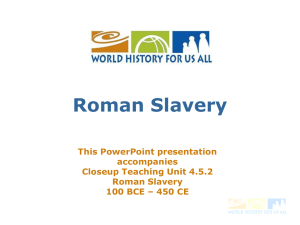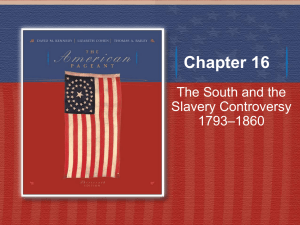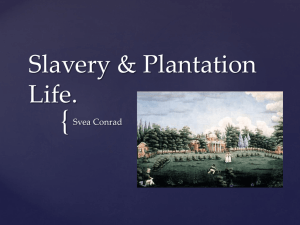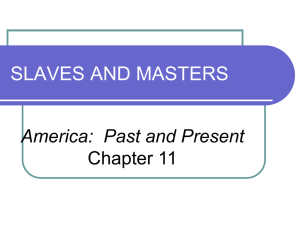File
advertisement
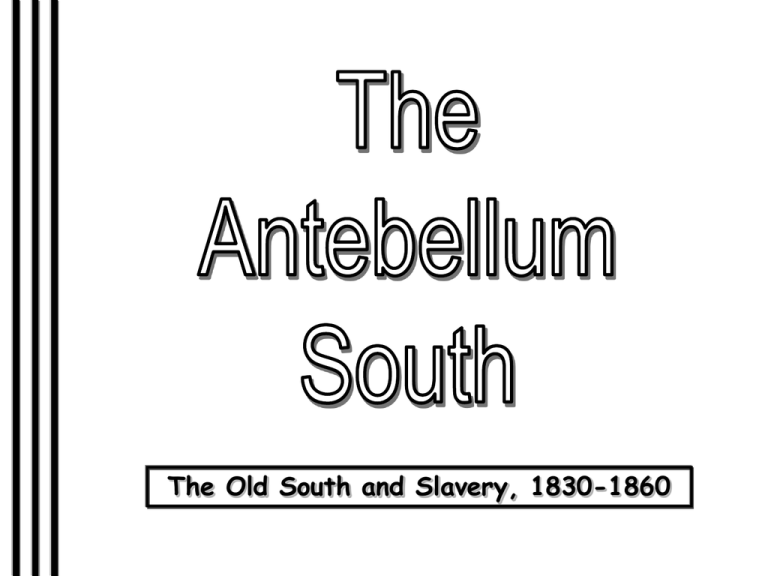
The Old South and Slavery, 1830-1860 Early Emancipation in the North Missouri Compromise, 1820 Define: • In 1775, slavery had known no sectional boundaries. But as Northern states embraced emancipation. The “Old South” became distinguished because it had slavery – Upper South: Virginia, North Carolina, Tennessee, and Arkansas *diversified economy (didn’t rely on cotton) – Lower (Deep) South: South Carolina, Georgia, Florida, Alabama, Mississippi, Louisiana and Texas (slavery & cotton) Introduction • The Upper South relied less on slavery and cotton than the Lower South • Upper South seceded from the Union more hesitantly • From 1832 on, what united and created the region the “Old South” was its defense of slavery – Its “peculiar institution” Questions We will cover the economy and society of the Old South from 1800 to 1860 • 1.) How did the rise of cotton cultivation affect the society and economy of the Old South? • 2.) What major social divisions segmented the white South? • 3.) Why did nonslaveholding whites feel their futures were tied to the survival of slavery? • 4.) What were the distinctive features of AfricanAmerican society and culture in the South? Characteristics of the Antebellum South 1. Primarily agrarian. 2. Economic power shifted from the “upper South” to the “lower South.” 3. “Cotton Is King!” * 1860 5 mil. bales a yr. (57% of total US exports). 4. Very slow development of industrialization. *4th largest producer of iron products (Tredegar Iron Works) 5. Rudimentary financial system. 6. Inadequate transportation system. Graniteville Textile Co. Founded in 1845, it was the South’s first attempt at industrialization in Richmond, VA King Cotton – The main cash crop of the colonial South was tobacco • Tobacco declined in the late 1700’s – Cotton culture revived southern agriculture • Encouraged rapid expansion southward and westward – Cotton growing was stimulated by: • the growth of the British textile industry • Development of the cotton gin • Removal of Indians from southern and western lands Changes in Cotton Production 1820 1860 Value of Cotton Exports As % of All US Exports Lure of Cotton • The climate of the Lower South was ideal for growing cotton • Intense demand in Britain kept prices high – Cotton could be grown profitably on any scale • With or without slave labor • Cotton cultivation and the institution of slavery did increase side by side • Cotton and corn were often grown together so that the South did not have to spend money on imported food Southern Agriculture Slaves Picking Cotton on a Mississippi Plantation Slaves Using the Cotton Gin Ties Between the Lower and Upper South • The Upper South identified with the Lower South rather than the free states: – Many of the Lower South residents had migrated from the Upper South – All southern whites benefited form the 3/5’s clause in the Constitution – Almost all southerners resented the criticism form northern abolitionists – The residents of the Upper South enjoyed a large, profitable business in the sale of slaves to the Lower South The North and South Diverge • While the North was rapidly industrializing and urbanizing, the South remained primarily rural and agricultural • Slaves could be and were employed in southern factories • Much of the South’s capital was tied up in slave ownership – Not available for investment in industrial development The North and South Diverge • Southerners believed that raising cash crops through slave labor would continue to be profitable • They lacked the incentive to switch their capital from land and slaves to financing industry • The South’s slave economy did not require a high rate of literacy • The Old South made less provision for public schools than the North – School attendance was not compulsory for southern whites – The law forbade teaching slaves to read and write The Social Groups of the White South – In 1860 • 1/4 of southern whites owned slaves • 1% of southern whites owned 100 or more – The whites of the Old South fit into 4 classes: • 1.) planters – Owners of more than 20 slaves • 2.) small slaveholders • 3.) yeoman – Nonslaveholding small family farmers • 4.) people of the pine barrens Southern Society (1850) 6,000,000 “Slavocracy” [plantation owners] The “Plain Folk” [white yeoman farmers]- Family farmers Black Freemen 250,000 Black Slaves 3,200,000 Total US Population 23,000,000 [9,250,000 in the South = 40%] Southern Population Slave-Owning Families (1850) Slave-Owning Population (1850) Planters and Plantation Mistresses • The plantation was almost a factory in the field – High degree of division of labor • The pursuit of profit led planters to: – look constantly for additional and more fertile land – Organize their slave crews as efficiently as possible – Seek favorable merchant-banker connections • To supplement their income – Many opened their homes to visitors • Responsibility of hospitality falling to their wives Planters and Plantation Mistresses • Psychological strains that plantation agriculture placed on planters and their wives included: – Isolation from other whites of their class – Frequent moves – Crude living conditions • Especially those who lived on the new frontier – Responsibilities of running a major economic enterprise • An additional stress on planters’ wives was the sexual double standard – Accepted illicit sexual relations between masters and their bondswomen – Demanded absolute sexual purity from white females Plantation Reality or Myth? Hollywood’s Version? A Real Georgia Plantation The Southern “Belle” The Small Slaveholders • By 1860, 88% of all slaveholders owned less then 20 slaves • In the lower south these farmers saw # of slaves as measure of success. • Many pushed Westward to get more land. Therefore they could put more slaves to work. The Yeoman • Nonslaveholding family farmers. • *comprised the largest single group of southern whites. • Would hire slaves at harvest time. • Smaller landholdings and ranged between subsistence farming and commercial • * goal was self-sufficiency with modest profit People of the Pine Barrens • • • • Made up about 10% of white population Did not own land or slaves Squatted on unfenced land Subsistence farming – Grazed hogs and cattle – Grew corn • Refused to work as hired help for others • Survived in this manner Social Relations in the White South • Introduction – Southern white society showed a mixture of aristocratic and democratic elements – There were great differences in wealth between classes – Most whites did own land – Planters were overrepresented in state legislatures – Did not always pass laws that only benefited themselves Conflict and Consensus in the White South • Planters leaned towards the Whigs • Yeomen towards the Democrats • Other characteristics of the Old South were minimized in conflict – The 4 main social groups were clustered in different regions and had little contact – Yeomen and planters were independent landowners – Whites rarely worked for other whites • Many worked side by side with their slaves • Planters dominated state legislatures • All white men had the right to vote by 1820’s – The planters could not ignore the desires of the yeomen majority Conflict over Slavery • Whites complained that the slave took away jobs. • Plantation owners took most of the South’s wealth (some suggested even reopening slave trade!) *envy rather than sympathy • 1857 The Impending Crisis of the South- Called for people to abolish slavery for the own interest So why didn’t the majority (non slaveholders) fight the institution? • 1. some hoped to become slaveholders • 2. accepted racial assumptions • 3. fear of what would happen if there was equality! The Proslavery Argument –pg349 • The proslavery argument was also used as a tool to unite southern whites behind the institution • Southern Whites constructed a defense of slavery as a positive good rather than a necessary evil. • Citing the history of slavery and the impact on Western civilization • Northern United States were “wage slaves” • Quoted the Bible, “slaves obey their masters” and natural submission of children to parents, wives to husbands. • ***Destroy the family!!! • Important Christian values such as humility and self control. Don't interrupt the “superior” social arrangements of the South • Southerners persuaded themselves of the righteousness of their “peculiar institution” • They also increasingly suppressed all public criticism of slavery – They seized and destroyed abolitionist literature mailed to the South – Smashed the presses of southern antislavery newspapers Southern Pro-Slavery Propaganda Violence, honor, and Dueling in the Old South • Throughout the Antebellum period violence deeply colored the daily lives of southerners. • Fighting consisted of biting, gouging, kicking and eye gouging. • Root of violence was the intensified feelings of personal pride. *didn’t want to be like slaves • SOUTHERN CODE OF HONOR- Gentlemen would duel. (save their honor) This bought time between insult and fight and most times confrontations ended peacefully • The murder rate was as much as 10 times higher in the South The Southern Evangelicals and White Values • The code of honor was potentially in conflict with the values preached by southern evangelical churches – Humility and self-restraint • From the 1830’s on, evangelical religion grew in influence to the point that some southern gentlemen did denounce drinking, gambling, and dueling as un-Christian practices • On the other hand, southern churches partly endorsed the gentry’s code of honor Life Under Slavery • Southern clergyman emphasized the Christian responsibilities of masters towards their slaves • Some masters were kind and other cruel (wanted to get the most out of their slaves) • Three things determined the slaves’ experience: – The kind of agriculture they worked – Resided in urban or rural areas – What century they lived in The Maturing of the Plantation System 1700 Slavery 1830 Slavery • Young man in his twenties brought from Africa • Worked on small isolated farms (many didn’t speak the same language) • More men then women so difficult to find a partner • Malnutrition led to fewer children • *without importation, slavery would have naturally declined • Born in America, spoke English and worked with numerous slaved on a plantation • As many women as men • Marriage rates rose • Importation from Africa declined after 1760 and in 1808 Congress banned it Work and Discipline of Plantation Slaves • • • • • Task System: each slave had a daily or weekly quota of tasks to complete (smaller units) Gang Labor: closely supervised and regimented (large cotton and sugar plantations) Day began with the sounding of a horn/bell, breakfast, then slaves marched off to the fields Slaves completed many tasks from fieldwork, housework, child rearing, carpentry, butchering animals *Slaves skilled in indoor work were greatly valued and treated accordingly • Regardless of the season, the slaves’ day stretched from dawn to dusk • Long hours and harsh discipline • Discipline was usually given by overseers and not masters. (the fall of the whip) The Slave Family • Slave owners encourage marriage. (discourage slaves from running away and to have children) • Law didn’t recognize or protect slave families and on average, a slave would witness the sale of eleven family members “until death of distance do you part.” • Buying and selling disrupted the stable family life • Mothers were separated from children by day and often were forced into relations with masters. The kin of this would be mistreated by master’s wife. • Despite all this, relationships were intimate and when possible, long-lasting. • Broad kinship ties between many generations marked the West African culture. • “Fictive” kin networks. Protected themselves from involuntary disruption The Longevity, Diet, and Health of Slaves • Slaves in the United Stated reproduced faster and lived longer than slaves taken other places – Gender ration equalized quicker than in other places – Old South produced plenty of food (corn and livestock) • Immunity to disease such as malaria and yellow fever were higher than whites but because there was no restrooms, drinking water became contaminated. • Cholera, dysentery and diarrhea were common • Came up with solutions to stomach ailments such as eating white clay (contains kaolin) • Suffered higher mortality than whites. Infant mortality was double of whites. 1 in 3 children dies before ten years of age. Slaves in Town and Free Blacks pg- 359 Slaves in town • Slaves had more opportunities for freedom in the Southern cities. Men worked in lumbering and sawmills and women/ children worked in textile mills • Easier to get skilled work in the South vs. the North because you weren’t competing with the immigrants • Working conditions were safer because masters didn’t want their slaves harmed/disabled Free Blacks • Most free blacks lived in cities • Carpenters, barrel makers, barbers, and even small traders. • Organized their own churches, literary journals and operas. • More than 250,000 free blacks in 1860 Slave Auction Notice & Sale, 1823 Slave Accoutrements Slave Master Brands Slave muzzle Anti-Slave Pamphlet Slave Accoutrements Slave leg irons Slave shoes Slave tag, SC Slaves posing in front of their cabin on a Southern plantation. A Real Mammie & Her Charge The Ledger of John White Matilda Selby, 9, $400.00 sold to Mr. Covington, St. Louis, $425.00 Brooks Selby, 19, $750.00 Left at Home – Crazy Fred McAfee, 22, $800.00 Sold to Pepidal, Donaldsonville, $1200.00 Howard Barnett, 25, $750.00 Ranaway. Sold out of jail, $540.00 Harriett Barnett, 17, $550.00 Sold to Davenport and Jones, Lafourche, $900.00 Slave Resistance Constant fears of slave resistance haunted the Old South. -Many areas blacks outnumbered the whites and there was constant talk of rebellion -Gabriel Prosser (1800) planned an uprising but was betrayed by other slaves and hung -Denmark Vesey (1822)- bought freedom and created a plan to seize Charleston, SC. Betrayed and executed -In the South whites could come together quickly to end a rebellion and they all had guns and soldiers -Family ties also made it reluctant to risk death and their their children parentless. -Some mulattos passed as whites, some forged/stole passes from plantations. All leading to their escape to the Free North Nat Turner’s Rebellion and the Consequences • • • • • • • • • • A religious preacher with many followers, Nat Turner decided to lead his people against slavery by killing slaveholders 8/22/1831 Turner and six others broke into a home in Virginia. Murdered entire family before moving on through the countryside collecting muskets, horses and recruits. Whites came from everywhere and followed path of destruction. Blacks were killed and Turner and his followers were either jailed or killed instantly Turner was an educated man who claimed vision and interpretations from the Bible. Caught and hung on 10/30/1831 Before Turner, white Virginians had worried little about a slave rebellion Many believed the to solve the problem emancipation was needed Proposals were defeated and over time opposition to slavery weakened. Slave Rebellions in the Antebellum South: Nat Turner, 1831 Slave Rebellions Throughout the Americas Slave Rebellions in the Antebellum South Gabriel Prosser 1800 1822 Slave Resistance 2. Refusal to work hard. 3. Isolated acts of sabotage. 4. Escape via the Underground Railroad. Runaway Slave Ads Quilt Patterns as Secret Messages The Monkey Wrench pattern, on the left, alerted escapees to gather up tools and prepare to flee; the Drunkard Path design, on the right, warned escapees not to follow a straight route. An Escape! • Harriet Tubman and Josiah Henson made repeated trips back to the South to help other slaves escape • Underground Railroad- organized network of safe houses owned by white abolitionists who spirited blacks to freedom in the North and Canada. • Escape was more of a dream than a reality. Out of millions of slaves only around 1,000 escaped to the North. • Most ran away to avoid punishment or to visit family, but stayed in the South • Instead of escape some slaves sought vengeance • Arson, poisoning, work stoppages, and negligence were alternatives to violent rebellion The Emergence of AfricanAmerican Culture – American blacks under slavery developed a distinctive culture • Drew on African and American cultures – But was “more than a mixture of the two.” The Culture of Slavery 1. Black Christianity : * more emotional worship services. * negro spirituals. The first Africans brought to the South were Muslims or followers of a variety of indigenous African religions By 1800 many had been converted to Christianity Methodists and Baptists 2. “Pidgin” or Gullah languages. This was an indispensable tool for communication A bridge to a distinctive black culture •3. Nuclear family with extended kin links, where possible. •4. Importance of music in their lives *the culture of blacks was “extremely expressive” •Expressed their feelings in shouts, music, and dance •They composed work songs and religious songs (spirituals) Conclusion • Slavery is what unified the Old South • Though the majority of white southerners owned no slaves, they had become convinced that the perpetuation of the “peculiar institution” was in the best interests of the entire South • Northerners believed that slavery made the South backward and bankrupt • Southern whites reacted to outside criticism by defending slavery as a benevolent way to handle the innate inferiority of the black race – Few slaves agreed





